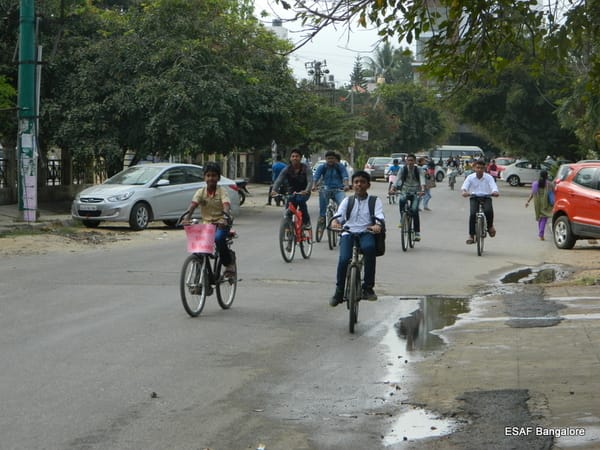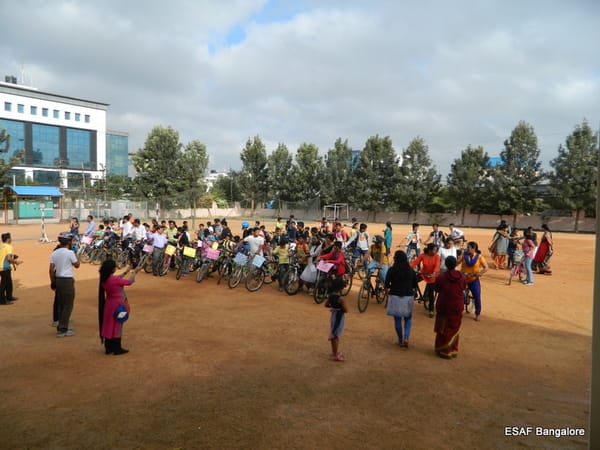Evangelical Social Action Forum (ESAF) in collaboration with JSS public school, HSR layout launched ‘Happy and Safe Route to School Program’ in HSR Layout. The launch was marked by cyclathon and walkathon. Nearly 100 people, including students, teachers and parents walked and cycled in a planned route to create awareness on the importance of active transportation to reduce pollution, congestion, leading an active and healthy life style.
In cities, rights of children to move around safely are infringed on various accounts. At the same time, the sedentary lifestyles to which children are exposed have contributed to various life style disorders and one being them is diabetes. Life style disorders can be combated by adopting active lifestyles. Walking and cycling to school is one of the easiest options one can have.

Pic: ESAF Bangalore
This event was supported by the HSR cyclists group and members of HSR citizens’ forum along with the Department of Traffic Police and Law and order. The rally took place on the 14th of November at 8.30 am on a planned route with necessary precautions taken to maintain safety of the students.
Active and Safe Routes to School is an initiative of ESAF Bangalore, an NGO who has been working on to encourage children, youth and their families to use active modes of transportation, such as walking and cycling, to get to and from school. ESAF is also a core member of BCOS (Bengaluru Coalition for Open Streets) who has initiated Cycle Day in Bangalore since October 2013. Active commuting has reduced these days due to schools not being in the immediate neighborhood, high number of motor vehicles on the road, rash driving, inadequate public transport or lack of last mile connectivity, paves the way for parents and students to choose private vehicles to drop children to school.
Resultantly, such children lose their passion towards their neighborhood environment and nature. Moreover, the public space crunch forces them into a sedentary lifestyle, engaged with the TV, internet or other gadgets. The prevalence of non-communicable, lifestyle diseases among children has seen a sharp rise. These effects can be reversed if we adhere to active transportation, which has the added benefits of reducing neighborhood traffic congestion and pollution, ensuring child safety and cutting down lifestyle diseases, increasing community awareness for a socially concerned generation and making an energized start to the day!

Pic: ESAF Bangalore
74 students, 7 teachers, 3 parents along with the Principal of JSS Public School cycled to create awareness in the neighborhood. The rally was led by the members of HSR cyclists group. Volunteers from HSR citizens’ forum were present to ensure safety of the students along with the members from the Department of Traffic Police. As a continuation and to take this program forward, interested parents shall be called upon and clubs shall be formed in the school that will initiate walking and cycling to school on a weekly basis. The program is also planned to be started in various other schools of HSR layout. Discussions’ with various school administrations have already begun.
The principal of the school was extremely enthusiastic from day one of discussions. She called upon teachers to participate which created a lot of excitement among the students. She said: “Children need to feel the joy of riding a cycle, that is when they shall want to cycle and walk to school every day. I have always loved cycling and used to cycle 10 KMS one way during my school days.” Parents of the students also tagged along with the students who were cycling at the rally, thus making them feel safe to ride on the busy streets of HSR layout. A parent said: “this is the first time my daughter has cycled to school, hope she enjoys herself like we used to in our younger days” and waited and watched the rally.
One of the teachers added: “We feel energised and fresh after cycling, children should know how that feels too!” One of the regular cyclist student said: “it’s fun to cycle to school and I do it everyday.”
ESAF started the campaign of walk to school – Active and Safe Routes to School Program in 2012. It was piloted at Presidency School, Kasturi Nagar (2014-2015) which led to school adopting the program as their own from 2015-2016. In 2015-2016, Cycle day team of Sanjay Nagar (CiFoS) along with support of Directorate of Urban Land Transport (DULT) launched the “Walk to School on Saturday Program (W2SS)” on the 5th of December, 2015.
The schools of Sanjaynagar have taken the responsibility upon themselves to encourage the students to walk and cycle to school daily from there on. The percentages of students walking and cycling have increased by a measurable quantity over the past year in all the schools that participated in Sanjaynagar.
This article was shared by ESAF team, and has been published with minimal edits, under the Message Forward section, a space for non-profit, public interest messages from individuals and organisations.
Related Articles
1,500 students took to the streets as part of the Walk to School program
Over 1000 students participate in civic awareness fest
Charting a safe route for school children in Bengaluru
Celebrating young messengers of change in Bengaluru